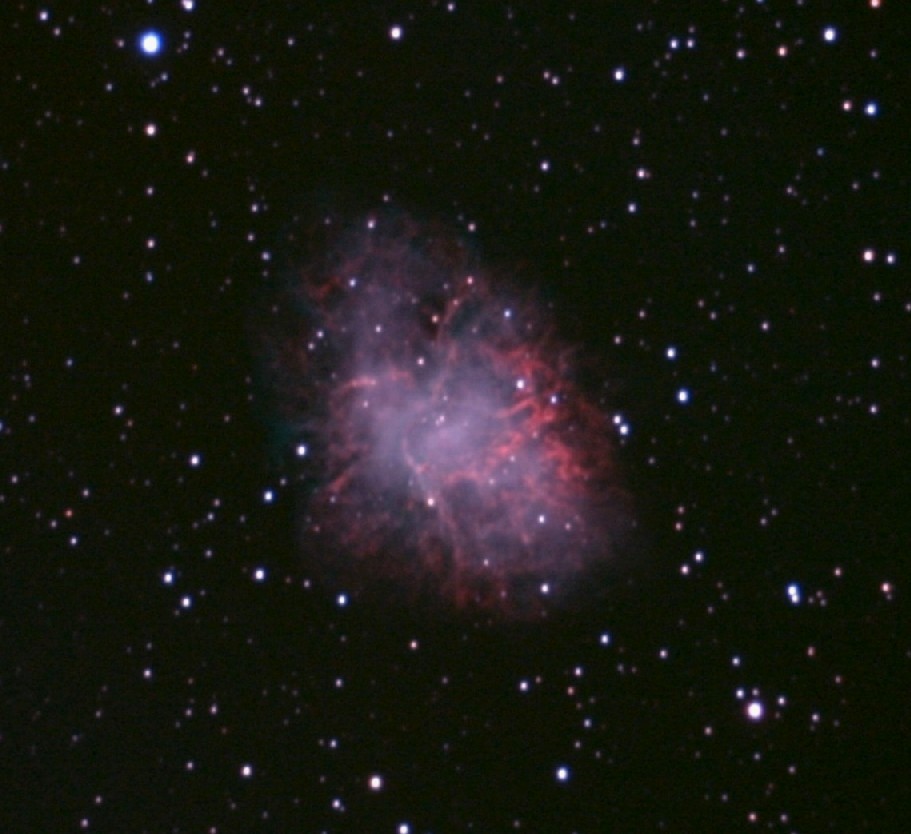
|
|
| M1, the Crab Nebula, or Heart Nebula, beating at about 33 beats per minute (this image cropped and reduced from the original photo) |
|
On July 4th in the year 1054 a new star appeared in the east a couple of hours before sunrise. Over the next week or so it became so bright it could easily be seen in broad daylight. Then it began to fade, until within 2 years it could no longer be seen even on the darkest and clearest of nights. Europe was in the depths of the dark ages then, so no recording of it was made there, but many other peoples did see and make note of it, including the Chinese (from whom we have the most extensive recorded observations), native Americans (rock drawings of it with the correct phase and position of the moon) Koreans, many Arab peoples, and several other groups as well. Today, with a telescope and our cameras we can see the smoke, dust, gas, and debris from that explosion, still glowing and billowing away from the core at speeds up to 1200 miles per second. Nearly a thousand years later now, it's expanded out to a bubble about 10 light years across. It blew up in a relatively empty part of space, so you get to see all the stuff that a star is made of. You don't see the shock wave and compression waves of the star's outer layers crashing into surrounding gas and material like you see around many other well known novas. The "crab" name comes from an interpretation of the early hand drawn picture of Lord Ross who observed and drew his impressions around 1844. It wasn't until better scopes and early photographs of the late 1800's that the "crab" disappeared, however the name stuck. Because of it's relatively close proximity and being able to pinpoint its time of origin, M1 has been of much interest to astronomers. Some now call it the heart nebula, which it actually does look a bit like, and even more interestingly, it "beats". Read on... Back in 1968 it gave astronomers a bit of a scare. This was back when aliens and extraterrestrial life were beginning to be suspected as a real possibility. A few years earlier funding was even made available to start scanning the electromagnetic spectrum for radio signals that might indicate life like ours. One of the most powerful indicators that we broadcast of our presence is the 50 and 60 cycle hum of our power grid radiating from tens of thousands of miles of high line wires. So when on November 9th 1968, a grad student at the Arecibo radio receiver in Puerto Rico found just such a signal coming from the M1 region, only at about a 33 cycle hum, they began to wonder if they'd just found alien life. For about 3 months, they tried to figure out what it might be other than aliens. During that time a couple of things became clear. First, it was a very real signal, but second, it was more powerful than anything that could ever come from any planet. In fact it was radiating with a power a thousand times greater than the total output of our sun. Eventually it was realized that it was the remnant core of the original star that had created the M1 nebula. The core was about the size of the earth, so it couldn't be seen, and it had a north and south magnetic pole as strong as the original star that was spinning at a little over 33 revolutions per second. So, to their disappointment, but relief, they got back to their astronomy, and haven't had such a scare since. |
|
10"
F6.3 Schmidt Cassegrain Telescope, Modified Canon 40D camera, placed at the scope's prime focus |